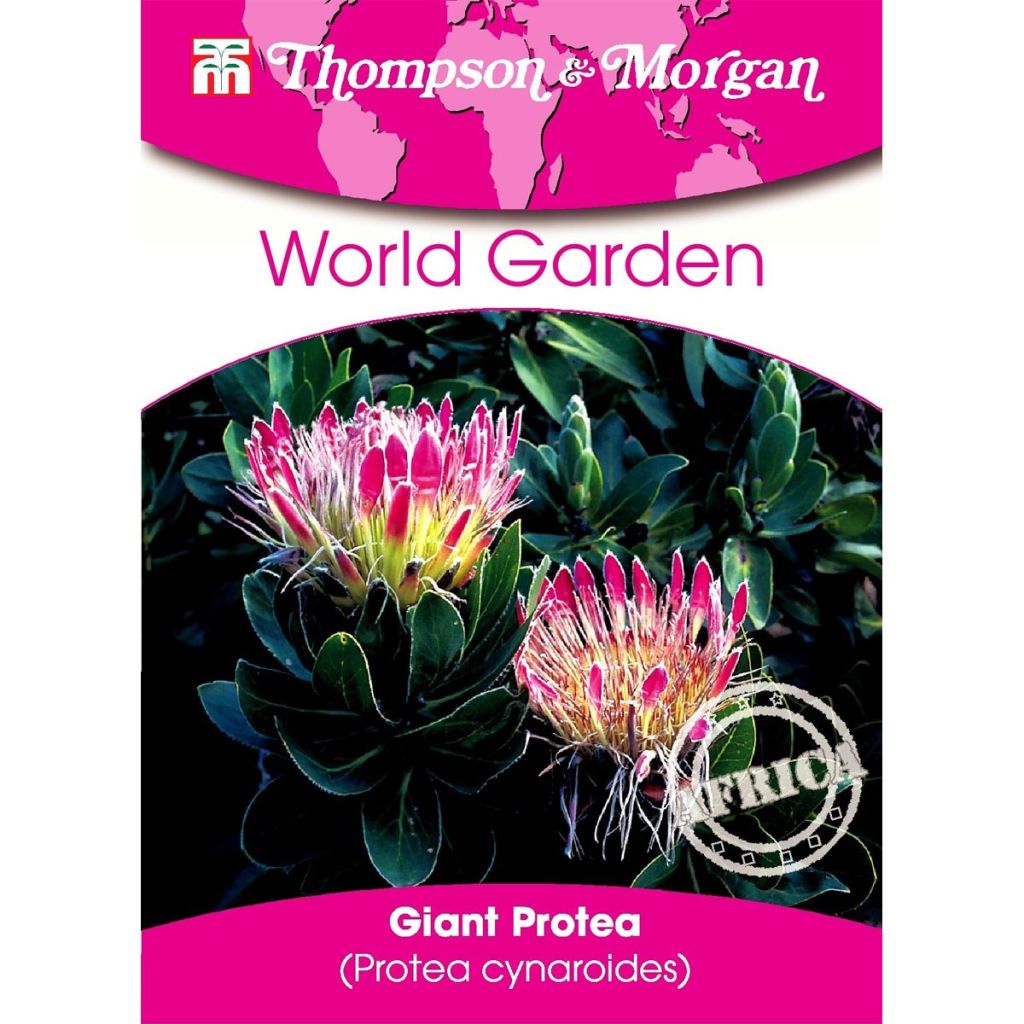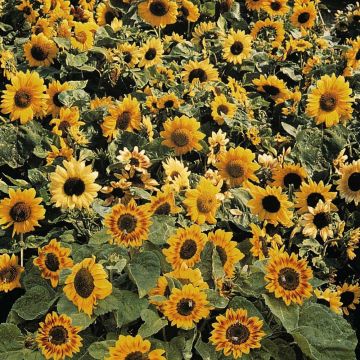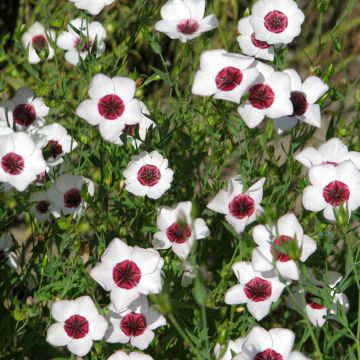

Graines de Protea cynaroides - Protée Royale
Protea cynaroides
Protea cynaroides
King Protea, Cape Artichoke Flower, Royal Protea
nothing
Maria D., 20/08/2018
This plant carries a 6 months recovery warranty
More information
We guarantee the quality of our plants for a full growing cycle, and will replace at our expense any plant that fails to recover under normal climatic and planting conditions.
Seed-only orders are dispatched by sealed envelope. The delivery charge for seed-only orders is 3,90 €.
Would this plant suit my garden?
Set up your Plantfit profile →
Description
The Protea cynaroides, also known as the King Protea, is the floral emblem of South Africa. It is a truly fascinating perennial plant, but not very hardy, which will be the pride of gardeners who enjoy challenges.
The King Protea is a perennial bushy plant that belongs to the Protea family. It is widely spread in South Africa and can adapt to mountainous environments. This plant is variable in colour and shape and is linked to the ecology of fire, which breaks the dormancy of its seeds.
The bush develops multiple thick, spreading stems from the base and slowly spreads over time, reaching a height between 40 cm (15.7 in) and 1 m (3 ft 4 in) 20. The long red petioles carry elongated, pointed, leathery, alternate leaves that can absorb atmospheric humidity. The King Protea can produce up to ten heads per season, held at each branch's end. The floral buds resemble magnificent artichokes with pearlescent scales, and the flowers are large heads that measure 12 to 30 cm (4.7 to 11.8 in) in diameter.
The head blooms with bright pink and velvety bracts that open onto a feathery plateau, white to pink, as if powdered. Flowering takes place from April to October and attracts numerous pollinating insects. The plant's thick roots also serve as a storage organ, and in the case of fire, it can regenerate from its roots, nourished by its own ashes.
King Protea is a sensational plant that amazes and delights. It should be planted in coastal gardens spared from heavy frosts, in light soil that is not too chalky. Typically adapted to the Mediterranean climate, it is happy to be planted with poor, dry, arid soils. It will look good alone on large slopes or in the background of dry garden beds, but always in an open situation, in full sun. In an exotic garden, it can be associated with Canary Island Bugloss, Euphorbia characias, Euphorbia mellifera, Giant Fennel, Giant Scabious, Melianthus major, or hybrid mulleins.
This evergreen species forms a spreading bush from the base, with floral heads reminiscent of large flared cups. Its pink feathery bracts surround a heart of powdered pink flowers. Depending on the climate, the flowering occurs from April to October and is very durable in dried bouquets. Cultivation in large pots is preferable in cooler temperatures. This treasure of nature deserves an attempt at sowing, sometimes requiring patience and precision.
Report an error about the product description
Flowering
Foliage
Plant habit
Botanical data
Protea
cynaroides
Proteaceae
King Protea, Cape Artichoke Flower, Royal Protea
South Africa
Other Thompson and Morgan seeds
Planting and care
When planting royal protea seeds, it is recommended to soak them in water for 24 hours. You can add a teaspoon of wood ash to the water to break the dormancy. Alternatively, expose the seeds to a strong heat source or smoke them over a green wood fire.
Sow the protea seeds between March and April. Sprinkle the sowing compost with ashes to promote germination. Place the seeds in full light behind a south-facing window and maintain a temperature between 18 to 22°C. Germination can take anywhere from 1 to 3 months.
Once the seeds have sprouted, transplant them into 8 cm (3.1 in) pots with a well-draining substrate from compost and river sand.
Royal protea seeds are large and can take several months to germinate. In nature, the seeds remain in the flower's short stem for 2 years before falling into the soil and germinating in the spring. This plant is adapted to the ecology of fire, and only the high temperature of a fire can quickly break the dormancy. The young royal proteas will need to be protected from frost during their first years but will eventually be able to withstand -5°C in dry soil. This plant typically flowers after 4 to 5 years of cultivation.
Sowing period
Intended location
-
, onOrder confirmed
Reply from on Promesse de fleurs
Flower seeds
Haven't found what you were looking for?
Hardiness is the lowest winter temperature a plant can endure without suffering serious damage or even dying. However, hardiness is affected by location (a sheltered area, such as a patio), protection (winter cover) and soil type (hardiness is improved by well-drained soil).

Photo Sharing Terms & Conditions
In order to encourage gardeners to interact and share their experiences, Promesse de fleurs offers various media enabling content to be uploaded onto its Site - in particular via the ‘Photo sharing’ module.
The User agrees to refrain from:
- Posting any content that is illegal, prejudicial, insulting, racist, inciteful to hatred, revisionist, contrary to public decency, that infringes on privacy or on the privacy rights of third parties, in particular the publicity rights of persons and goods, intellectual property rights, or the right to privacy.
- Submitting content on behalf of a third party;
- Impersonate the identity of a third party and/or publish any personal information about a third party;
In general, the User undertakes to refrain from any unethical behaviour.
All Content (in particular text, comments, files, images, photos, videos, creative works, etc.), which may be subject to property or intellectual property rights, image or other private rights, shall remain the property of the User, subject to the limited rights granted by the terms of the licence granted by Promesse de fleurs as stated below. Users are at liberty to publish or not to publish such Content on the Site, notably via the ‘Photo Sharing’ facility, and accept that this Content shall be made public and freely accessible, notably on the Internet.
Users further acknowledge, undertake to have ,and guarantee that they hold all necessary rights and permissions to publish such material on the Site, in particular with regard to the legislation in force pertaining to any privacy, property, intellectual property, image, or contractual rights, or rights of any other nature. By publishing such Content on the Site, Users acknowledge accepting full liability as publishers of the Content within the meaning of the law, and grant Promesse de fleurs, free of charge, an inclusive, worldwide licence for the said Content for the entire duration of its publication, including all reproduction, representation, up/downloading, displaying, performing, transmission, and storage rights.
Users also grant permission for their name to be linked to the Content and accept that this link may not always be made available.
By engaging in posting material, Users consent to their Content becoming automatically accessible on the Internet, in particular on other sites and/or blogs and/or web pages of the Promesse de fleurs site, including in particular social pages and the Promesse de fleurs catalogue.
Users may secure the removal of entrusted content free of charge by issuing a simple request via our contact form.
The flowering period indicated on our website applies to countries and regions located in USDA zone 8 (France, the United Kingdom, Ireland, the Netherlands, etc.)
It will vary according to where you live:
- In zones 9 to 10 (Italy, Spain, Greece, etc.), flowering will occur about 2 to 4 weeks earlier.
- In zones 6 to 7 (Germany, Poland, Slovenia, and lower mountainous regions), flowering will be delayed by 2 to 3 weeks.
- In zone 5 (Central Europe, Scandinavia), blooming will be delayed by 3 to 5 weeks.
In temperate climates, pruning of spring-flowering shrubs (forsythia, spireas, etc.) should be done just after flowering.
Pruning of summer-flowering shrubs (Indian Lilac, Perovskia, etc.) can be done in winter or spring.
In cold regions as well as with frost-sensitive plants, avoid pruning too early when severe frosts may still occur.
The planting period indicated on our website applies to countries and regions located in USDA zone 8 (France, United Kingdom, Ireland, Netherlands).
It will vary according to where you live:
- In Mediterranean zones (Marseille, Madrid, Milan, etc.), autumn and winter are the best planting periods.
- In continental zones (Strasbourg, Munich, Vienna, etc.), delay planting by 2 to 3 weeks in spring and bring it forward by 2 to 4 weeks in autumn.
- In mountainous regions (the Alps, Pyrenees, Carpathians, etc.), it is best to plant in late spring (May-June) or late summer (August-September).
The harvesting period indicated on our website applies to countries and regions in USDA zone 8 (France, England, Ireland, the Netherlands).
In colder areas (Scandinavia, Poland, Austria...) fruit and vegetable harvests are likely to be delayed by 3-4 weeks.
In warmer areas (Italy, Spain, Greece, etc.), harvesting will probably take place earlier, depending on weather conditions.
The sowing periods indicated on our website apply to countries and regions within USDA Zone 8 (France, UK, Ireland, Netherlands).
In colder areas (Scandinavia, Poland, Austria...), delay any outdoor sowing by 3-4 weeks, or sow under glass.
In warmer climes (Italy, Spain, Greece, etc.), bring outdoor sowing forward by a few weeks.





















































